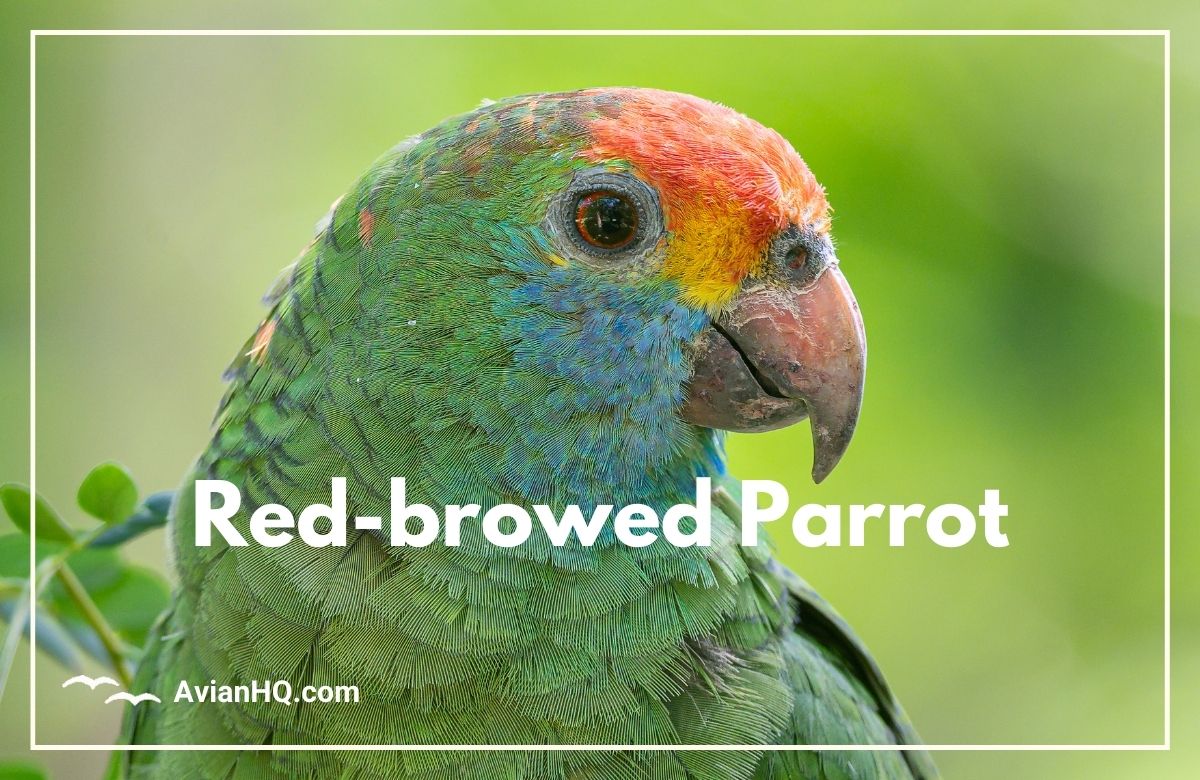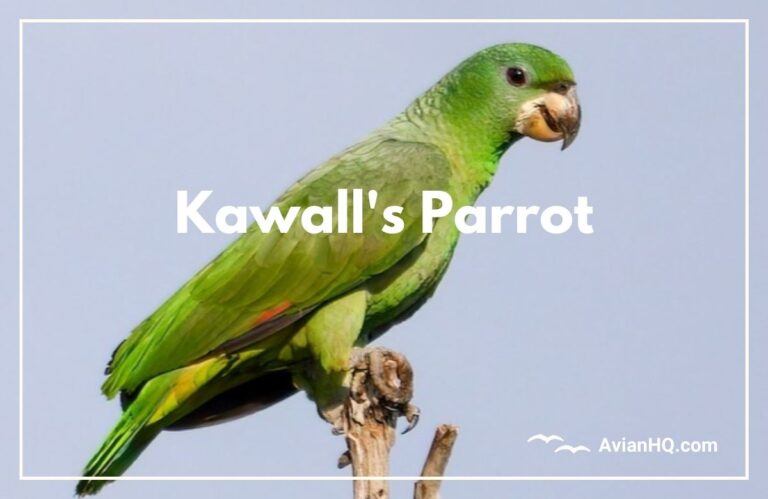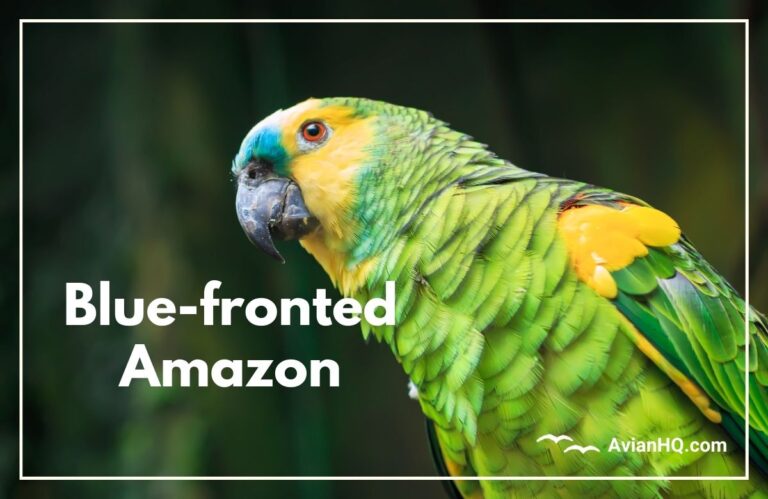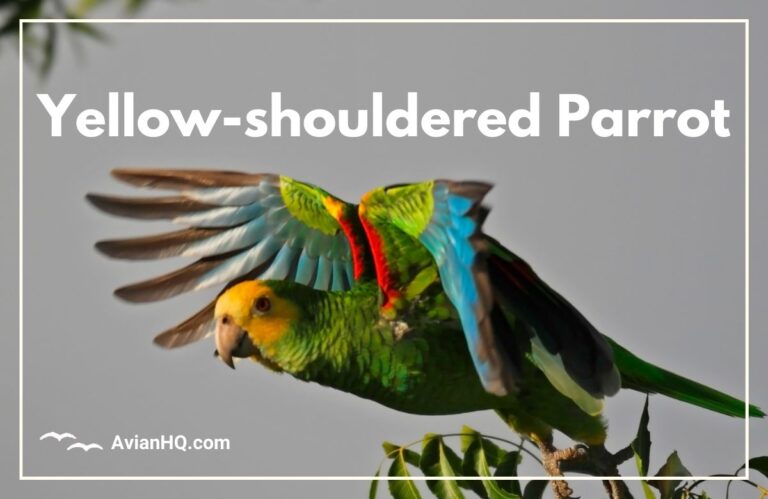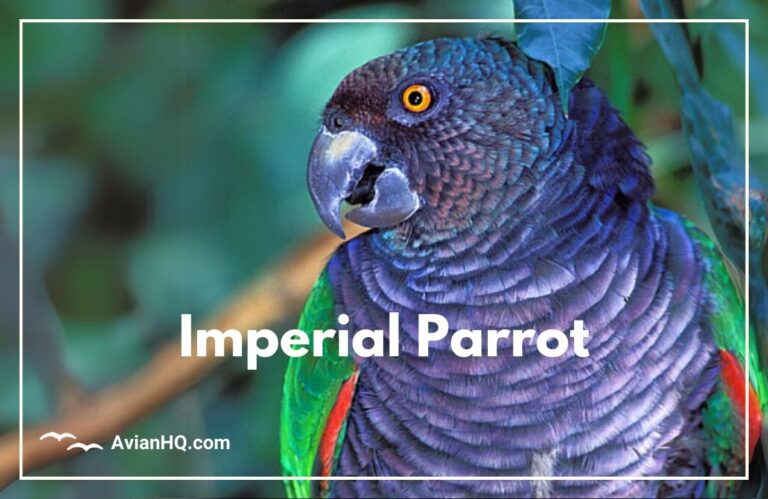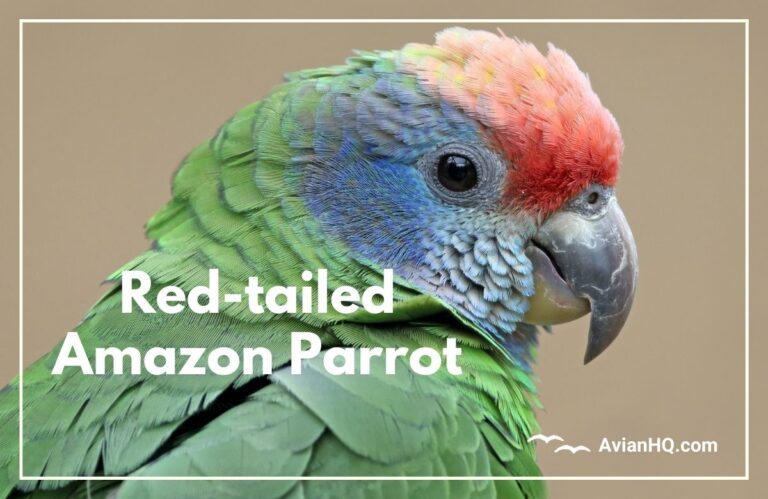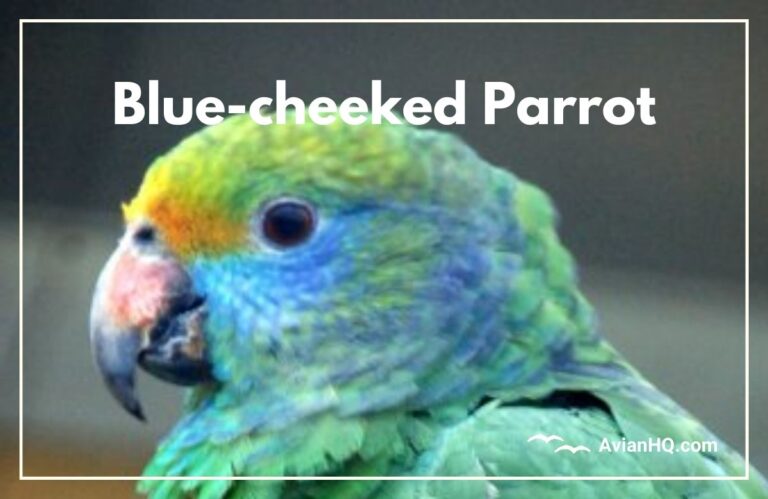Red-browed Amazon Parrot (Amazona rhodocorytha)
The brilliant red forehead and fiery orange eyes first catch your attention. Then you notice the vibrant blue cheeks and green body. You are gazing at an extraordinary bird – the Red-browed Parrot.
“The Red-browed Parrot’s bright colors hint at its endangered status. Habitat loss threatens this rare Brazilian endemic.”
This medium-sized parrot, measuring around 14 inches (35 cm) long, is a Brazilian native found only in remnants of Atlantic Forest on Brazil’s eastern coast. Its restricted range and declining habitat have conservationists concerned. By learning more about this vulnerable species, you can appreciate its uniqueness and why protecting it matters.
In this article, you’ll discover the natural history, physical appearance, habitat, behavior, conservation status, and cultural importance of the Red-browed Parrot. Understanding such a rare and threatened bird involves unraveling details in each of these areas.
- What does scientific classification reveal about its taxonomy?
- How do its bright colors aid survival?
- Why is its specialized habitat disappearing?
- How do breeding behaviors affect conservation?
- What conservation steps can preserve remaining populations?
Let’s begin unfolding the mysteries of the Red-browed Parrot. Through this overview, you’ll comprehend why this Brazilian Atlantic Forest endemic needs committed conservation to persist in the changing landscape it calls home.
History and Taxonomy
The Red-browed Parrot entered the scientific literature in 1818. German naturalist Georg Marcgrave provided the first written record noting its occurrence in Brazil’s Pernambuco state. For years, taxonomists classified it as a subspecies of the more widespread Blue-cheeked Parrot.
Research in the late 1900s confirmed it as a distinct species, granting the Red-browed Parrot full species status as Amazona rhodocorytha.
Its scientific name comes from Latin and Greek roots. “Amazona” honors the legendary female warriors of Greek mythology. “Rhodocorytha” means red-crowned, directly describing the bright red cap extending down the parrot’s forehead. No subspecies of the Red-browed Parrot exist.
Early documents focused on northeastern Brazil due to European colonization patterns. Today, experts recognize the species’ range as a 500 mile (800 km) coastal strip from Alagoas to Rio de Janeiro states. Though nowhere common within this zone, the parrot frequents various fragmented forest blocks. Identifying and protecting each population segment presents an ongoing conservation challenge.
Physical Appearance
The bright red forehead declining to a purplish nape gives this parrot its common name. Several striking features stand out in its plumage.
- Size and Weight – Length averages 13-14 inches (35 cm). Weight ranges between 14-16 ounces (450 grams).
- Head – Its namesake red crown tapers into blue cheeks and throat. The beak is gray. Eyes shine reddish-orange.
- Body – Breast and abdomen exhibit bright grass green feathers. The back and wings show some dark scalloping.
- Tail – Elongated tail sports red and yellow marks, with blue and green on the outer feathers.
- Legs – Sturdy gray legs and zygodactyl feet allow grasping and climbing.
Overall, the red, blue, and green predominant hues likely play a role in mate attraction. The species exhibits little variation in plumage across its range. No difference occurs between the sexes though females tend to have a more muted green coloration.
Juveniles start out with less vibrant facial colors. Their crown presents washed out green hues and the throat shows grayish blue initially. After their first year, juveniles molt into adult plumage.
Habitat and Distribution
The Red-browed Parrot resides solely along Brazil’s Atlantic coast. Its habitat niche is tropical rainforest within 328 feet (100 meters) of the ocean. Specifically, it occupies remnant patches of Atlantic Forest.
At one time, Atlantic Forest stretched some 1,200 miles (2,000 km) along southeastern Brazil. Today only 7% of this forest remains.
The parrot’s current range extends approximately 500 miles (800 km) through six Brazilian states:
- Alagoas
- Bahia
- Espírito Santo
- Minas Gerais
- Rio de Janeiro
- São Paulo
Though this seems a broad distribution, the species frequents a tiny fraction of its historic range. Fewsizeable forest tracts still exist. One stronghold is Sooretama Biological Reserve in Espirito Santo. Other key refuges are fragments in Bahia and Rio de Janeiro.
Within suitable forest, these parrots mainly inhabit the canopy. Some seasonal movement to higher elevations up to 3,300 feet (1,000 meters) occurs. But their niche is lowland rainforest. Few birds persist outside protected zones due to habitat loss and trafficking. Safeguarding remaining populated reserves is crucial.
Diet and Feeding
The Red-browed Parrot is specialized to eat ripe fruits and seeds within rainforest trees. Its strong beak and nimble tongue are adapted for foraging offerings from flowers, fruits, buds, and bark.
Documented food items span native species like:
- Fig
- Palm
- Cecropia
And agricultural crops such as:
- Papaya
- Mango
- Cocoa
- Coffee
They exhibit seasonal preferences based on availability. For instance, they seek out palm fruit in the dry season. But their mainstay is figs from canopy trees.
Red-browed Parrots are somewhat nomadic while foraging. They traverse their home range feeding on localized abundance. Small groups of less than 30 birds forage at fruiting or flowering trees. Then they may move up to 6 miles (10 km) to the next temporary feast.
At night, they gather in large flocks at communal roosts. Dozens shelter together, perhaps to deter predators through safety in numbers. As light dawns, pairs and small parties scatter out to feed. This daily rhythm persists year-round.
Breeding and Reproduction
The breeding ecology of wild Red-browed Parrots is poorly understood. However, some aspects of their reproduction are known.
- Nest sites – They nest in tree cavities, often those carved out by woodpeckers. The same site may be reused for several years.
- Clutch size – In captivity, clutches range from 2-4 white eggs. Comparable brood sizes likely occur in nature.
- Incubation period – Eggs hatch after 24 days of warming incubation. Both parents share brooding duties.
- Fledging age – Chicks develop quickly, leaving the nest about 8 weeks from hatching. They appear fully feathered but still rely on parental care.
- Breeding season – Most breeding activity seems concentrated September through November. But more study is needed to detail the timing and synchronization with food resources.
Successful reproduction requires undisturbed nest sites and plentiful food. Chicks begging calls need to avoid attracting predators. The pressures of habitat fragmentation may upset these delicate balances. Ensuring breeding success in protected forests is an ongoing conservation goal.
Behavior and Ecology
The Red-browed Parrot exhibits behaviors shared by other Amazona parrots along with unique adaptations to its habitat. Its patterns of activity reflect living in small fragments of Atlantic Forest.
- Social flocking – Outside breeding season, Red-browed Parrots forage and roost communally in flocks of less than 30 individuals. These groups likely help locate scattered food sources and provide safety from predators.
- Pair bonding – Monogamous pairs form long-term bonds. Pairs may cooperate in defending nest sites and territories. Both sexes share parental care of eggs and chicks.
- Canopy use – Nimble flight through the forest allows exploiting flowers and fruits in the upper levels. Their unique bills and tongues extract resources other birds cannot access.
- Seasonal movements – Some elevation shifts occur between lowland and highland areas. But this species is not a long-distance migrant compared to temperate bird species.
- Interactions – Red-browed Parrots may associate in feeding flocks or at roosts with the related Orange-winged Parrot where their ranges overlap. But competition for nest sites might occur with that more aggressive species.
Understanding such ecological relationships can guide effective conservation planning for this rare species. Preserving sufficient habitat and food resources supports key behaviors like breeding and seasonal flocking.
Conservation Status
The survival of the Red-browed Parrot hangs in the balance. Habitat loss and trapping have left apenas 700-1,200 birds remaining. Classified as “Vulnerable” by the International Union for Conservation of Nature (IUCN), its fate mirrors the dwindling Atlantic Forest. Without urgent interventions, extinction may occur within decades.
- Population – Surveys from 2000-2009 estimated 600-2,500 mature individuals. But only 700-1,200 likely persist currently amid ongoing threats. Quantifying precise numbers across fragmented habitat proves challenging.
- Threats – Over 90% of original habitat has been converted for agriculture, cattle ranching, and cities over the last century. What scattered fragments remain face logging, firewood harvesting, and infrastructure projects. Though trade is banned, nest poaching still occurs, removing potential breeding pairs.
- Protection Efforts – Brazil protects the species under wildlife trafficking laws. Several reserves like Sooretama and Rio Doce host populations. But poor funding hampers enforcement. Conservation groups advocate new reserves, forest restoration, anti-poaching patrols, and community engagement to enable survival. But political and economic headwinds stall meaningful progress so far.
- Captive Assurance Colonies – North American and European zoos manage captive assurance populations as a hedge against extinction. Breeding programs aim to sustain at least several dozen birds. But without habitat and in situ protections, captive collections offer only temporary genetic storage, not genuine salvation.
Grim deficiencies in habitat plus inadequate anti-trafficking laws could doom the Red-browed Parrot. Even well-designed reserves suffer invasions. Turning the tide requires economic initiatives supporting Atlantic Forest restoration combined with greatly strengthened legal sanctions on poaching. Absent forceful conservation campaigns on these fronts soon, the window for recovery may close for good.
Conclusion
The Red-browed Parrot’s dazzling colors and specialized rainforest niche make it a Brazilian jewel. Yet unchecked threats have brought it to the verge of extinction. This Atlantic Forest endemic now ranks among Brazil’s most endangered birds.
As its limited habitat shrinks further, estimates indicate just 700-1,200 Red-browed Parrots cling to survival. Their bright plumes and uniqueness evolved over eons. But human encroachment could erase this species in mere decades without urgent conservation interventions.
Ensuring more robust populations requires coordinated action:
- Expand and connect protected reserves across its range through forest restoration
- Fund vigilant anti-poaching units to curb nest trafficking
- Engage local communities as stewards through awareness and incentives
- Captive breeding can preserve genetic diversity but not replace wild birds
By learning about rare species like the Red-browed Parrot, we appreciate the interwoven complexity of life. An animal exquisitely adapted to a niche habitat reflects evolutionary wonder. When human activities threaten such species, we lose more than individual organisms. We sacrifice pieces of our planet’s intricate tapestry, fraying connections vital for biodiversity.
Yet conservation biology offers hope, even for critically endangered species. Through committed financial investments and policy changes, we can pull the Red-browed Parrot back from the abyss. In the process, we redeem part of our own humanity and expand chances for our descendants to marvel at this parrot’s crimson crown gracing Brazil’s green cathedrals. We preserve an inheritor of ages past while securing the health of habitats still nurturing life into unknown ages ahead.

